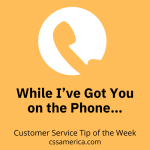One way to look at the difference between proactive and reactive is that proactive is something that’s often done before it absolutely has to be done. Maybe it’s something done that really doesn’t have to occur, but your professionalism takes over, and some action or communication that you know in your gut should be performed is performed. Reactive is an after-the-fact action. You’re in that tennis match, and somebody just hit a volley over the net, so now the ball’s in your court.
In customer service, oftentimes we have advanced knowledge of what could happen, or we know before the customer what did happen. And the difference between proactive and reactive in this case is that we are initiating contact with the customer or on behalf of the customer when we’re being proactive. When being reactive, we rarely act on that advanced knowledge, and therefore find ourselves reacting when the customer learns of the issue in some other way than hearing it from us.
With proactive communications, we’re more in control because we’re initiating the engagement. With reactive communications, we’re often dealing with the emotions of somebody else and are unprepared emotionally or informationally.
Let’s assume that it’s usually better to be proactive than reactive; so, here are 4 actions to consider if you want to be more proactive:
Give the Update: Let the customer know if there’s going to be a delay, if things are on track, what next steps they need to consider. Keep them in the loop without them having to ask for an update.
Follow-Up: After a purchase or a request is filled or an issue is resolved, touch base with the customer to ensure they got the need met and they’re satisfied with the result.
Suggest Something Beneficial: If you know the customer and their needs well, recommend a product or service that might be helpful to them. Selling is not a bad word in customer service if what you’re suggesting benefits the customer.
Remind about Maintenance: If they need to update their account information, download a mobile app, do routine maintenance on a car, or fill out some paperwork, give them a friendly reminder so that they’re not in a situation where they miss a deadline or are dealing with something out-of-date.
To do something with tangible benefits for the customer, take these four actions.
Signup for FREE Tips! Contact Us More Resources for You Visit Our Home Page












